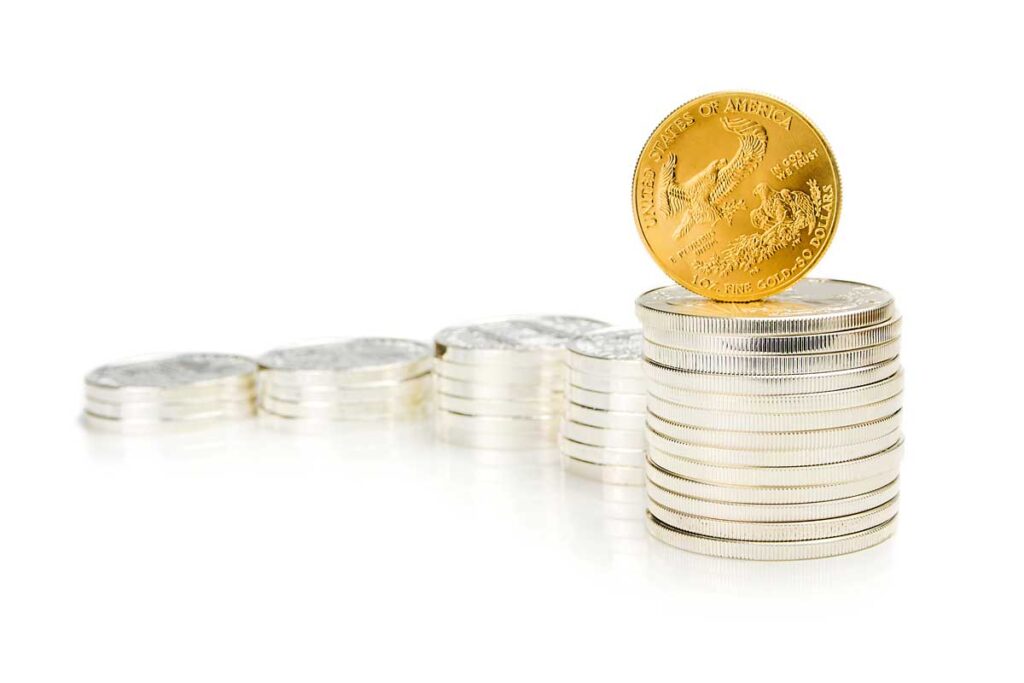How Does a Gold IRA Work?
A Gold IRA works exactly like any retirement account with the added benefit that it provides you more control over your investment to include physical gold coins and bars and other IRS approved silver, platinum and palladium metals.
Similar to any retirement account, with your Gold IRA or Custom Precious Metals IRA, you will be investing your retirement funds based on specific tax treatment (pre-tax or after-tax) and then take distributions in future. With your Gold IRA or Custom Precious Metals IRA, you will continue to have beneficiary (ies), receive quarterly statements and be able to log in online to check your balances
How Does a Gold IRA Work?
A Gold IRA works exactly like any retirement account with the added benefit that it provides you more control over your investment to include physical gold coins and bars and other IRS approved silver, platinum and palladium metals.
Similar to any retirement account, with your Gold IRA or Custom Precious Metals IRA, you will be investing your retirement funds based on specific tax treatment (pre-tax or after-tax) and then take distributions in future. With your Gold IRA or Custom Precious Metals IRA, you will continue to have beneficiary (ies), receive quarterly statements and be able to log in online to check your balances.
Types of Gold IRA Accounts
As with conventional retirement accounts, there are few types of accounts that each provide distinct tax benefits. The following are the three types of Gold IRA Accounts:
Traditional Gold IRA:
A traditional gold IRA is a tax-deferred retirement savings account and works just like pre-tax traditional IRAs when it comes to taxes. Your contributions and any gains will not be taxed and, in most cases, contributions are tax deductible as well. The IRS sets annual contribution limits of $5,500 if you are under 50 and $6,500 if you are above 50. With a pre-tax IRA you will have to pay taxes on your distributions during retirement.
Roth Gold IRA:
A Roth Gold IRA is an after-tax retirement savings account and works just like any Roth IRA. While there is not any upfront tax deduction with Roth IRA contributions, the main advantage of a Roth IRA is that you won’t have to pay any taxes down the line when you start to take distribution during retirement.
SEP Gold IRA:
SEP gold IRAs are available to business owners and self-employed individuals. The SEP Gold IRA works similarly to a pre-tax traditional IRA, in that your contributions are not taxed, but it offers higher contribution limits. Instead of the $5,500 limit, you can contribute up to 25% of your income or $53,000, whichever is less.
Gold IRA Review can help you navigate regulatory requirements, avoid tax pitfalls and diversify with physical precious metals to stabilize your retirement portfolio.
Does My Account Qualify?
Majority types of retirement accounts are qualified to be transferred all or portion, on a tax-deferred, penalty-free basis, into a Gold IRA or a custom precious metals IRA.
While traditional IRA, Roth IRA, Simplified Employee Pension (SEP) IRA, and Savings Incentive Match Plan for Employees of Small Employers (SIMPLE) are free of any rollover restrictions, others such 401k, 403b, 457b and Thrift Savings Plan (TSP), are qualified to be transferred if the individual is over 59 ½ years old or no longer works with prior employer.
Most accounts can be transferred on a tax-deferred, penalty-free basis with the exception of annuities which could, depending on the contract, have a surrender charge. However, an experienced IRA specialist will help you uncover if there are any surrender charges.
A verified Gold IRA Company we make the process of protecting your investment with precious metals easy. A team of an IRA specialist and a Senior Portfolio Managers will help you throughout the process and handle all the paper works.
Setting Up a Gold IRA Account
Setting up a Gold IRA is very simple. Opening your account can be either completed online by clicking the following link or through a physical application.
Your Gold IRA representatives are there to assist you every step of the way.
Fund Your Gold IRA
With your application completed and your self-directed IRA open, funding your Gold IRA cannot get easier. Funding the account is simple and can be completed by one of the three methods:
IRA Transfer:
The new IRA can be funded through an IRA to IRA transfer by simply completing a Transfer Request Form. This will ensure that the transfer is completed on a tax-deferred and penalty-free basis.
IRA Rollover:
A direct rollover from a 401(k) or other qualified retirement plan is another way to fund your self-directed IRA on a tax-deferred basis.
Cash Contributions:
To fund the account with cash, the self-directed custodian will accept either a check or wire. The taxable treatment depends on the type of the IRA account either pre-tax (traditional) or after-tax (Roth) basis.
One of the few limitations on funding your account is that you can’t legally fund it with gold coin or bullion you already own, in part because the U.S. government only allows certain coins and bullion to be held in IRAs.
Once the funds are received by the new self-directed IRA custodian, your Gold IRA representative will help you select the IRS approved coins and the depository to store your precious metals. Most designated Gold IRA associates, both an IRA specialist and a Senior Portfolio Manager, will manage the entire process of setting up and funding your Gold IRA or custom precious metals IRA.
IRA Approved Coins
A gold IRA or a custom precious metals IRA cannot hold just any type of physical gold or precious metals. With the Taxpayer Relief Act of 1997, the IRS approved the following four main precious metals to be invested into an IRA: gold, silver, platinum and palladium. With each type of metal, the IRS only allowed a select few forms of bullion, coins, rounds and bars. In an effort to focus on investment grade liquid products and limit collectibles older types of coins, the IRS issued requirements of fineness for the precious metals products. One reason for being selective is to ensure that the gold and other precious metal products meet minimum requirements likely to ensure better long-term value.
The following coins and bars are among those that meet IRA investment requirements. Gold coins and bullion must be 99.5% finess or higher.
- American Eagle and
- American Eagle Proof coins
- American Buffalo coins
- Canadian Maple Leaf coins
- Canadian Polar Bear & Cub
- Canadian Polar Bear
- Canadian Arctic Fox
- Austrian Philharmonic coins
- Australian Kangaroo coins
- British Britannia (2013 and newer)
- Chinese Panda coins
- Credit Suisse bars and other bars and rounds produced by an NYMEX or COMEX-approved refinery
- Silver coins and bullion must be .999 fineness or higher.
This list is not all-inclusive, and we know determining whether precious metals are appropriate for IRA investments can be tough, which is why our Allegiance Gold account executives are always ready to provide assistance.
Depository Storage
If you are interested in rolling the funds in your traditional IRA into physical precious metals, you must decide how you wish to store them before funding a Self Directed IRA. Your Allegiance Gold account executive will answer any questions you may have and help you determine which type of storage will work best for your retirement savings needs.
Depository Storage Facility for IRA
A Depository Storage Facility is a third party storage facility where all precious metals in storage are insured. With depository storage, your precious metals are stored in a high-security facility that’s 100 percent insured against all loss, damage, theft or other liability These Depository Storage facilities have highly advanced security mechanisms and tools such as timed locks, 24 hours monitoring system, automatic relocking, and vibration, motion, and sound detectors. All depositories provide all risk insurance and maintain a $1 billion insurance coverage through Lloyd’s of London.
According to the IRS, gold and other precious metals in a retirement account are required to be stored in the custody of an IRS-approved custodian at a third party storage facility until the funds are withdrawn on reaching the predefined retirement age. Putting your precious metals in depository storage ensures that they are fully protected
There is an added layer of security with any depository. When a depository receives any products, it will first inspect, audit, confirm, key in the product annotating the type, quantity and weight and then securely store the precious metals products.
Top Three Depository Storage Facilities:
- Delaware Depository (Wilmington, Delaware)
- International Depository Services
- Brinks (Los Angeles, CA or Salt Lake City UT)
Commingled Vs. Segregated Storage
Precious metals stored in a commingled storage option are held in a communal area along with other people’s products. Precious metals kept in segregated storage will be separated from all other precious metals at the depository in a storage compartment reserved for private use. Both segregated and non-segregated storage provide an equally strong degree of protection.
There are two options of storage:
Commingled:
A commingled storage in a Gold IRA or a Custom Precious Metals IRA simply means that your precious metals will be held in a segregated storage area based on the custodian but will be commingled with other customers within the storage area. When you later decide to sell, exchange or take an in-kind distribution of your precious metals, you will receive “like” precious metals and not the exact metals that you initially purchased.
Segregated:
A segregated storage in a Gold IRA or a Custom Precious Metals IRA ensures that your precious metals will be held in a separate storage area and will be segregated, marked and stored with your name and IRA account number. When you later decide to sell, exchange or take an in-kind distribution of your precious metals, you will receive the exact metals that you initially purchased.



